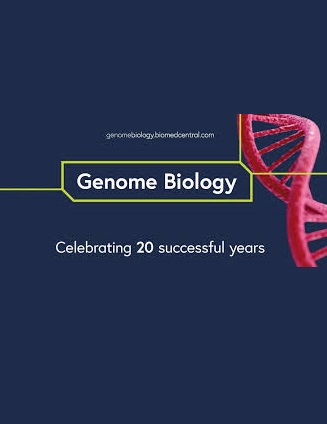CpG 岛更替事件可预测增强子活性的进化变化
IF 10.1
1区 生物学
Q1 BIOTECHNOLOGY & APPLIED MICROBIOLOGY
引用次数: 0
摘要
改变转录增强子功能的基因变化与物种间生物多样性的进化有关。多项研究关注核苷酸置换、转座、插入和缺失在改变增强子功能中的作用。CpG 岛(CGIs)最近被证明会影响增强子的活性,在此我们测试了它们在不同物种间的更替是如何促进增强子进化的。我们整合了从九个哺乳动物物种的多种组织中获得的CGI和增强子活性相关组蛋白修饰图谱,发现增强子中的CGI含量与组蛋白修饰水平的增加密切相关。CGI在不同物种间呈现出广泛的更替,而物种特异性CGI在所有组织和物种中表现出物种特异性活性的增强子中具有很强的富集性。与具有物种特异性 CGI 的增强子相关的基因在表达上表现出一致的偏向,这证明 CGI 的更替有助于基因调控的创新。我们的研究结果还表明,CGI的更替也与人类增益增强子(HGEs)的进化有关,HGEs在人类胚胎发育过程中显示出更强的活性,可能有助于人类独特性状的进化。通过使用人源化小鼠模型,我们发现小鼠同源物中不存在大 CGI 的高度保守 HGE 在人源化小鼠间脑中的人类 CGI 处显示出更高的活性。总之,我们的研究结果表明,CGI 的转换是驱动基因调控变化的一种机制,它可能是哺乳动物性状进化的基础。本文章由计算机程序翻译,如有差异,请以英文原文为准。
CpG island turnover events predict evolutionary changes in enhancer activity
Genetic changes that modify the function of transcriptional enhancers have been linked to the evolution of biological diversity across species. Multiple studies have focused on the role of nucleotide substitutions, transposition, and insertions and deletions in altering enhancer function. CpG islands (CGIs) have recently been shown to influence enhancer activity, and here we test how their turnover across species contributes to enhancer evolution. We integrate maps of CGIs and enhancer activity-associated histone modifications obtained from multiple tissues in nine mammalian species and find that CGI content in enhancers is strongly associated with increased histone modification levels. CGIs show widespread turnover across species and species-specific CGIs are strongly enriched for enhancers exhibiting species-specific activity across all tissues and species. Genes associated with enhancers with species-specific CGIs show concordant biases in their expression, supporting that CGI turnover contributes to gene regulatory innovation. Our results also implicate CGI turnover in the evolution of Human Gain Enhancers (HGEs), which show increased activity in human embryonic development and may have contributed to the evolution of uniquely human traits. Using a humanized mouse model, we show that a highly conserved HGE with a large CGI absent from the mouse ortholog shows increased activity at the human CGI in the humanized mouse diencephalon. Collectively, our results point to CGI turnover as a mechanism driving gene regulatory changes potentially underlying trait evolution in mammals.
求助全文
通过发布文献求助,成功后即可免费获取论文全文。
去求助
来源期刊

Genome Biology
Biochemistry, Genetics and Molecular Biology-Genetics
CiteScore
21.00
自引率
3.30%
发文量
241
审稿时长
2 months
期刊介绍:
Genome Biology stands as a premier platform for exceptional research across all domains of biology and biomedicine, explored through a genomic and post-genomic lens.
With an impressive impact factor of 12.3 (2022),* the journal secures its position as the 3rd-ranked research journal in the Genetics and Heredity category and the 2nd-ranked research journal in the Biotechnology and Applied Microbiology category by Thomson Reuters. Notably, Genome Biology holds the distinction of being the highest-ranked open-access journal in this category.
Our dedicated team of highly trained in-house Editors collaborates closely with our esteemed Editorial Board of international experts, ensuring the journal remains on the forefront of scientific advances and community standards. Regular engagement with researchers at conferences and institute visits underscores our commitment to staying abreast of the latest developments in the field.
 求助内容:
求助内容: 应助结果提醒方式:
应助结果提醒方式:


